- Obecnie brak na stanie
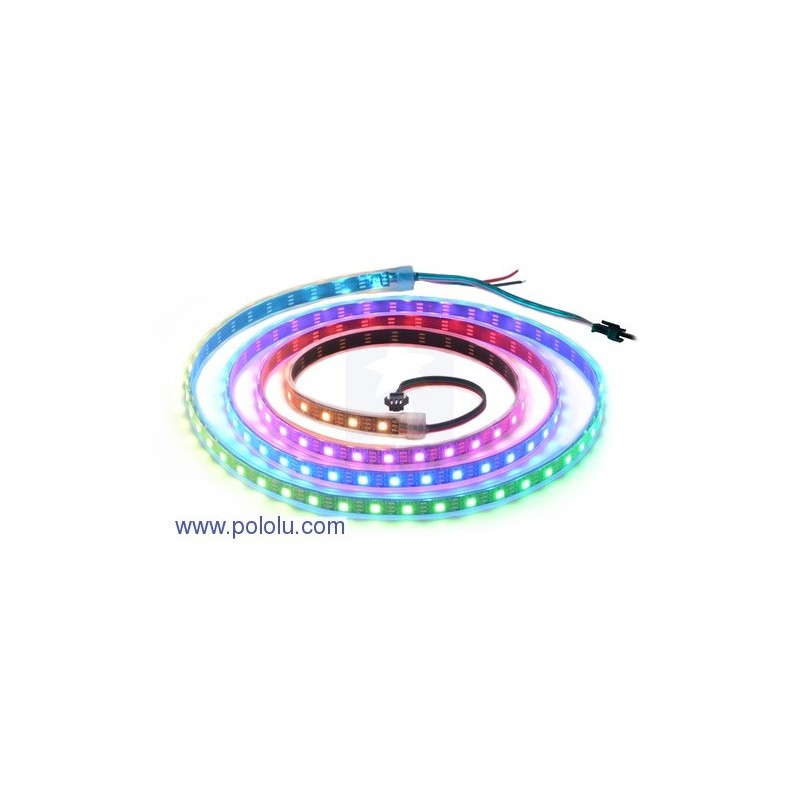
Addressable RGB 120-LED Strip, 5V, 2m (WS2812B)
This 2-meter long strip contains 120 RGB LEDs that can be individually addressed using a one-wire interface, allowing you full control over the color of each RGB LED. The flexible, waterproof strip runs on 5 V and can be chained with additional WS2812B strips to form longer runs or cut apart between each LED for shorter sections.
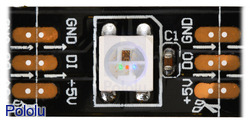 |
| Close up of one segment of a WS2812B-based LED strip, with the red, green, and blue LEDs on at their dimmest setting. |
|---|
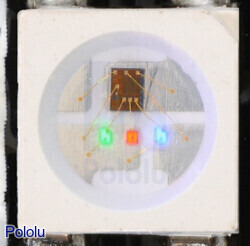 |
| Close up of a WS2812B, with the red, green, and blue LEDs on at their dimmest setting. |
|---|
These flexible RGB LED strips are an easy way to add complex lighting effects to a project. Each LED has an integrated driver that allows you to control the color and brightness of each LED independently. The combined LED/driver IC on these strips is the extremely compact WS2812B (essentially an improved WS2811 LED driver integrated directly into a 5050 RGB LED), which enables higher LED densities. In the picture on the right, you can actually see the integrated driver and the bonding wires connecting it to the green, red, and blue LEDs, which are on at their dimmest setting.
We offer five different kinds of WS2812 LED strip with different LED densities and lengths. These ones have 30 LEDs per meter:
We also offer these denser WS2812 LED strips that have 60 LEDs per meter:
The information on this page applies to all of the WS2812-based LED strips we sell.
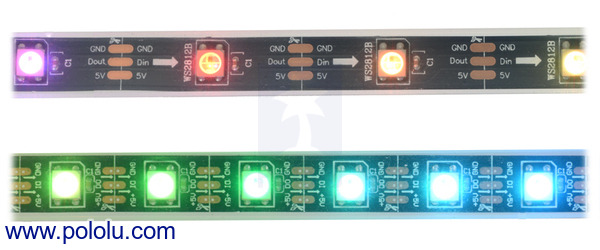 |
| LED side of the WS2812B-based addressable LED strips. The upper strip has 30 LEDs per meter and the lower strip has 60 LEDs per meter. |
|---|
 |
| The connectors and power wires for our WS2812B-based LED strips. On the left is the input end of the strip and on the right is the output end. |
|---|
Each LED strip has three connection points: the input connector, the auxiliary power wires, and the output connector. These can be seen in the adjacent picture, from left to right: auxiliary power wires, input connector, output connector. The strip uses 3-pin JST SM connectors.
The input connector has three male pins inside of a plastic connector shroud, each separated by about 0.1". The black wire is ground, the green wire is the signal input, and the red wire is the power line.
The auxiliary power wires are connected to the input side of the LED strip and consist of stripped black and red wires. The black wire is ground, and the red wire is the power line. This provides an alternate (and possibly more convenient) connection point for LED strip power.
The output connector is on the other end of the strip and is designed to mate with the input connector of another LED strip to allow LED strips to be chained. The black wire is ground, the green wire is the signal output, and the red wire is the power line.
All three black ground wires are electrically connected, and all three red power wires are electrically connected.
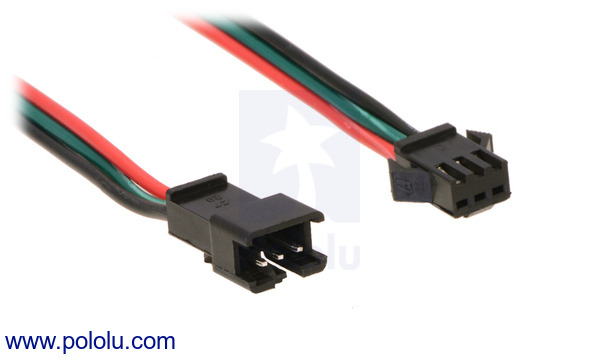 |
| A close-up of the JST SM connectors for our WS2812B-based LED strips. |
|---|
These LED strips ship with 5 flexible plastic brackets and 10 screws per meter. The brackets fit over the waterproof sheath and can be used to mount the LED strip. The LED strip also ships on a plastic reel.
|
|
 |
| Controlling an addressable RGB LED strip with an Arduino and powering it from a 5V wall power adapter. |
|---|
To control the LED strip from a microcontroller, two wires from the input connector should be connected to your microcontroller. The LED strip’s ground (black) should be connected to ground on the microcontroller, and the LED strip’s signal input line (green) should be connected to one of the microcontroller’s I/O lines. The male pins inside the input connector fit the female terminations on our premium jumper wires and wires with pre-crimped terminals. If you are connecting the LED strip to a breadboard or a typical Arduino with female headers, you would want to use male-female wires.
We generally recommend powering the LED strip using the auxiliary power wires. Our 5 V wall power adapters work well for powering these LED strips and a DC Barrel Jack to 2-Pin Terminal Block Adapter can help you make the connection between the adapter and the strip. However, you might need a wire stripper to strip off some more insulation from the power wires.
It is convenient that the power wires are duplicated on the input side because you can connect the auxiliary power wires to your 5 V power supply and then the power will be available on the data input connector and can be used to power the microcontroller that is controlling the LED strip. This means you can power the microcontroller and LED strip from a single supply without having to make branching power connections.
Warning: The WS2812B seems to be more sensitive than our original TM1804-based LED strips. We recommend connecting a capacitor of at least 100 µF between the ground and power lines on the power input and generally following good engineering practices when handling and using this product (e.g. take precautions against electrostatic discharge (ESD) and avoid making or changing connections while the circuit is powered). If the strip does get damaged, it is often just the first LED that is broken; in such cases, cutting off this first segment and resoldering the connector to the second segment brings the strip back to life.
Each RGB LED draws approximately 50 mA when it is set to full brightness and powered at 5 V. This means that for every 30 LEDs you turn on, your LED strip could be drawing as much as 1.5 A. Be sure to select a power source that can handle your strip’s current requirements.
There is some resistance in the power connections between the LEDs, which means that the power voltage near the end of the strip will be less than the voltage at the start of the LED strip. As the voltage drops, RGB LEDs tend to look redder and draw less current. This voltage drop is proportional to the current through the strip, so it increases when the LEDs are set to a higher brightness.
We tested the current draw and voltage drop of some LED strips by setting all the LEDs to full brightness, and these were the results:
The voltage drop was computed by measuring the voltage difference between ground and power on the input end of the strip, then doing the same measurement on the output end, and subtracting the two values.
Multiple LED strips can be chained together by connecting input connectors to output connectors. When strips are chained this way, they can be controlled and powered as one continuous strip. Please note, however, that as chains get longer, the ends will get dimmer and redder due to the voltage drop across the strip. If this becomes an issue, you can chain the data lines while separately powering shorter subsections of the chain.
 |
| Two WS2812B-based addressable RGB LED strips connected. |
|---|
We recommend chains of LEDs powered from a single supply not exceed 180 total RGB LEDs. It is fine to make longer chains with connected data lines, but you should power each 180-LED section separately. If you are powering each section from a different power supply, you should cut the power wires between the sections so you do not short the output of two different power supplies together.
The LED strip is divided into segments, with each segment containing one RGB LED. The strip can be cut apart on the lines between each segment to separate it into usable shorter sections. The data connection is labeled DO, Dout, DI, or Din, the positive power connection is labeled 5V, and the ground connection is labeled GND. Each LED in the picture below is at the center of its own segment; there are little scissors drawn on the PCB silkscreen where the segments can be cut.
 |
These LED strips are controlled by a simple, high-speed one-wire protocol on the input signal line. The protocol is documented in the WS2812B datasheet (266k pdf) and also below.
The default, idle state of the signal line is low. To update the LED colors, you need to transmit a series of high pulses on the signal line. Each high pulse encodes one bit: a short pulse (0.35 µs) represents a zero, while a long pulse (0.9 µs) represents a one. The time between consecutive rising edges should be 1.25 µs (though in our tests, the strips worked with cycle times up to approximately 6 µs). After the bits are sent, the signal line should be held low for 50 µs to send a reset command, which makes the new color data take effect (note: it is possible for low pulses as short as 6 µs to trigger a reset). The pulse widths do not have to be precise: there is a threshold that determines whether the pulse is a 0 or a 1, and a wide range of pulse widths on both sides of the threshold will work.
 |
| WS2812B RGB data timing diagram. |
|---|
The color of each LED is encoded as three LED brightness values, which must be sent in GRB (green-red-blue) order. Each brightness value is encoded as a series of 8 bits, with the most significant bit being transmitted first, so each LED color takes 24 bits. The first color transmitted applies to the LED that is closest to the data input connector, while the second color transmitted applies to the next LED in the strip, and so on.
 |
| 24 bits represent the color of one WS2812B LED in an addressable WS2812B RGB LED strip. |
|---|
To update all the LEDs in the strip, you should send all the colors at once with no pauses. If you send fewer colors than the number of LEDs on the strip, then some LEDs near the end of the strip will not be updated. For example, to update all 30 LEDs on a 1-meter strip, you would send 720 bits encoded as high pulses and then hold the signal line low for 50 µs. If multiple strips are chained together with their data connectors, they can be treated as one longer strip and updated the same way (two chained 1-meter strips behave the same as one 2-meter strip).
Each RGB LED receives data on its data input line and passes data on to the next LED using its data output line. The high-speed protocol of the WS2812B allows for fast updates; our library for the Arduino below takes about 1.1 ms to update 30 LEDs, so it is possible to update 450 LEDs faster than 60 Hz. However, constant updates are not necessary; the LED strip can hold its state indefinitely as long as power remains connected.
Since this LED strip does not use a standard protocol, a software bit-banging approach is usually needed to control it from a microcontroller. Because of the sub-microsecond timing, the bit-banging code generally needs to be written in assembly or very carefully optimized C, and interrupts will need to be disabled while sending data to the LED strip. If the interrupts in your code are fast enough, they can be enabled during periods where the signal line is low.
Note: The minimum logic high threshold for the strip data line is 3.5 V, so you should use level-shifters if you want to control these strips from 3.3 V systems. In our tests, we were able to control them with 3.3 V signals from an mbed, but using the strip out of spec like this could lead to unexpected problems.
To help you get started quickly, we provide sample code for these microcontroller platforms:
Additionally, the Adafruit NeoPixel library for Arduino should work with these strips since the NeoPixels are based on the WS2812B.
These WS2812B-based strips are similar in many ways to our older high-speed TM1804 LED strips (items #2543, #2544, and #2545). The WS2812B’s timing parameters are very similar to those of the high-speed TM1804 LED strips, so you can use the same code to control either of them and you can chain one type to the other. However, the two types of strips have different, incompatible connectors, and the order of the red and green channels in the protocol is swapped: the TM1804 colors are sent in red-green-blue order while the WS2812B colors are sent in green-red-blue order.
The TM1804 is just an LED driver and it requires a separate RGB LED to be placed on the strip. Since the WS2812B combines the LED and the driver in a single package, it can be packed more densely, which is why we are able to offer strips with 60 LEDs per meter.
Unlike the TM1804 strips, these LED strips do not have an adhesive backing, but they do include mounting brackets as described above.
Producent BTC Korporacja sp. z o. o. Lwowska 5 05-120 Legionowo Polska sprzedaz@kamami.pl 22 767 36 20
Osoba odpowiedzialna BTC Korporacja sp. z o. o. Lwowska 5 05-120 Legionowo Polska sprzedaz@kamami.pl 22 767 36 20
Brak towaru
Brak towaru
Moduł z mikrofonem MEMS i wzmacniaczem, który pozwoli wykryć głos, klaśnięcie, czy trzaśnięcie drzwiami. Płytka ma wyprowadzone wyjście analogowe. SparkFun BOB-18011
Brak towaru
Taśma połączeniowa IDC7 o długości 20cm. Służy do połączenia ze złączem I2S komputera Odroid C4
Brak towaru
Zestaw z modułem RM500Q-AE przeznaczony do współpracy z minikomputerem Raspberry Pi. Wspiera sieci 5G, 4G oraz 3G i obsługuje pozycjonowanie GNSS. Waveshare RM500Q-AE 5G HAT (with case) (EU)
Brak towaru
Miernik cęgowy UT204 przeznaczony jest do pomiaru prądu przemiennego i stałego, napięcia przemiennego i stałego, rezystancji oraz częstotliwości. Wyposażony jest w funkcję pomiaru względnego, funkcję Hold,True RMS oraz automatyczną zmianę zakresów. Uni-T UT204
Brak towaru
Brak towaru
Brak towaru
ESP32-P4-WIFI6-DEV-KIT-B to kompletne środowisko deweloperskie z wyświetlaczem dotykowym, kamerą i głośnikiem, idealne do tworzenia interfejsów użytkownika, urządzeń interaktywnych i systemów automatyki z obsługą Wi-Fi 6, BLE i Ethernet. Zestaw umożliwia szybkie prototypowanie projektów z przetwarzaniem obrazu, dźwięku i integracją z platformami AI.
Brak towaru
Brak towaru
Brak towaru
GD32F103CBT6, Mikrokontroler ARM Cortex-M3; SRAM:20kB; Flash:128kB; 108MHz; LQFP48
Brak towaru
Moduł RTC do Banana Pi łączy się z komputerem za pomocą magistrali I2C. Umożliwia jednoczesne podłączenie kaskadowo do 8 modułów. W zestawie znajduje się bateria.
Brak towaru
Uniwersalny organizer z 36 przegrodami. Pozwala przechowywać niewielkie części i narzędzia. BOX0001
Brak towaru
Brak towaru
Rozszerzenie SparkFun Cellular Shield z modułem MG2639 umożliwia transmisję danych i głosu przez GSM/GPRS oraz korzystanie z odbiornika GPS. Można w kilka chwil stworzyć skuteczny lokalizator GPS. (CEL-13120)
Brak towaru

Addressable RGB 120-LED Strip, 5V, 2m (WS2812B)
